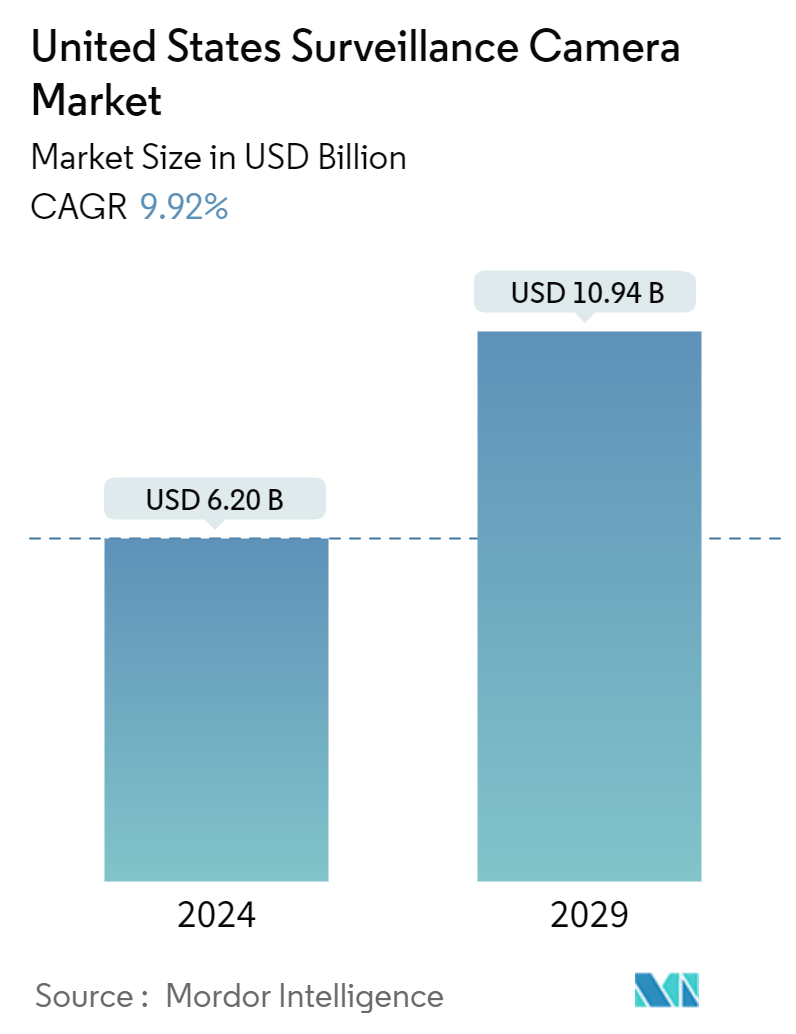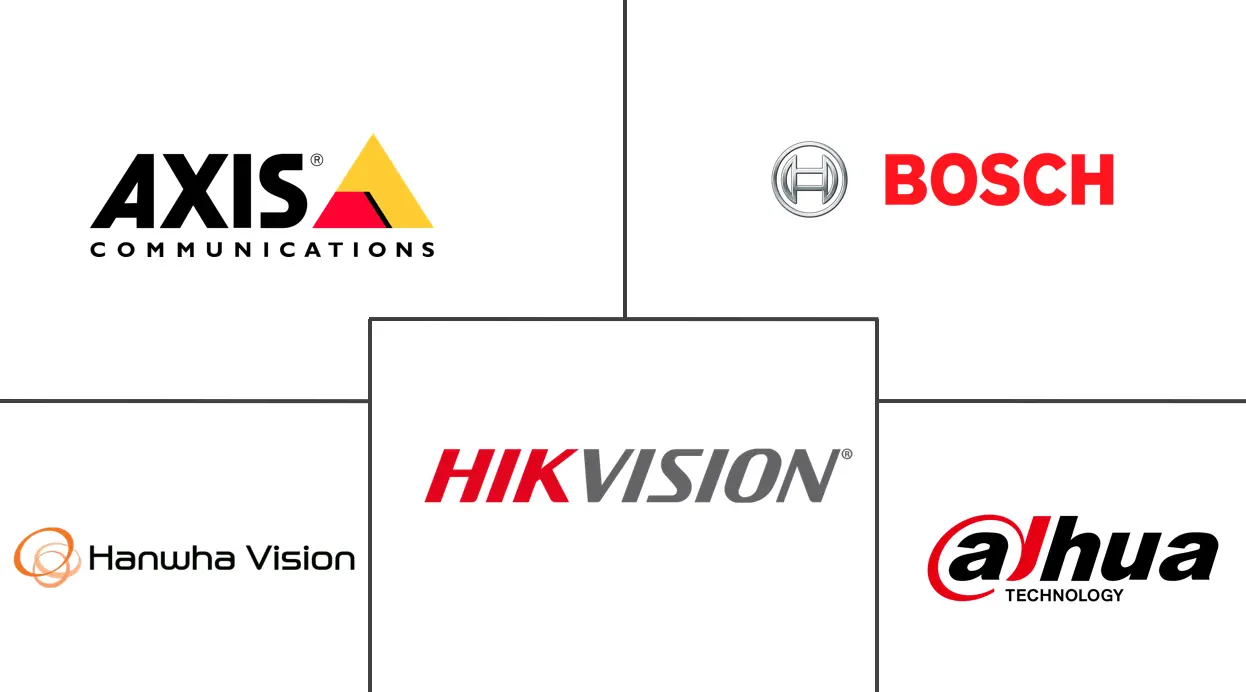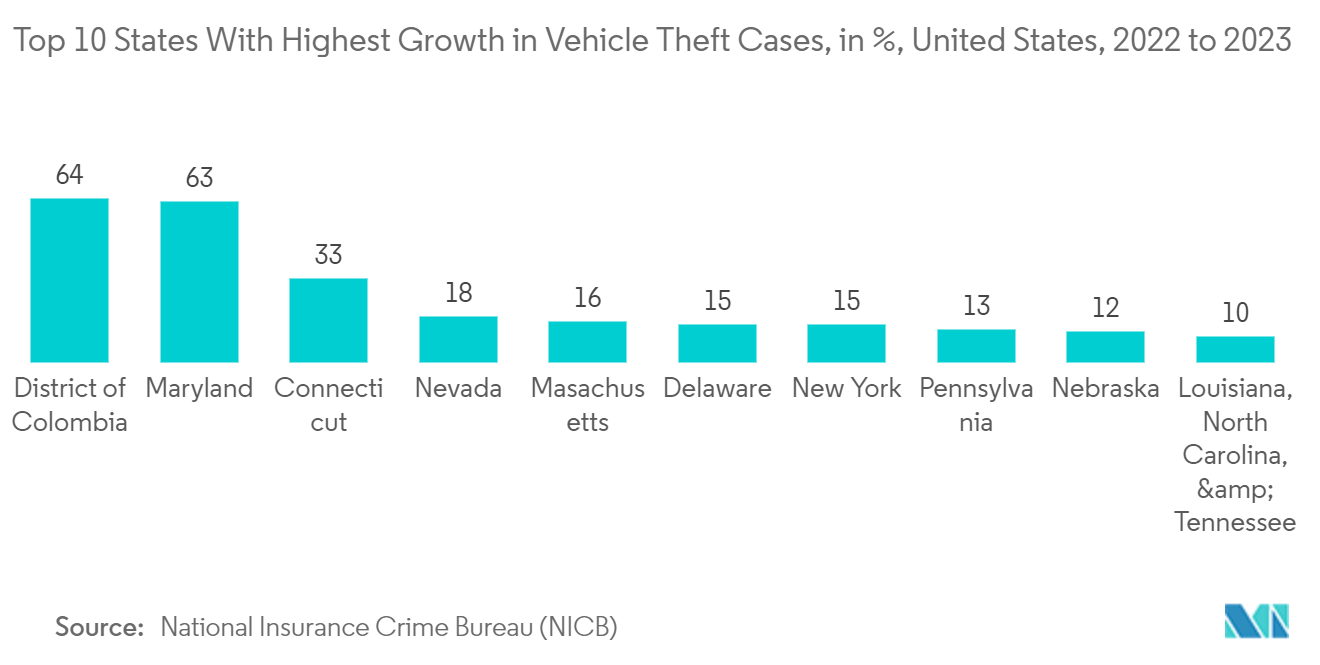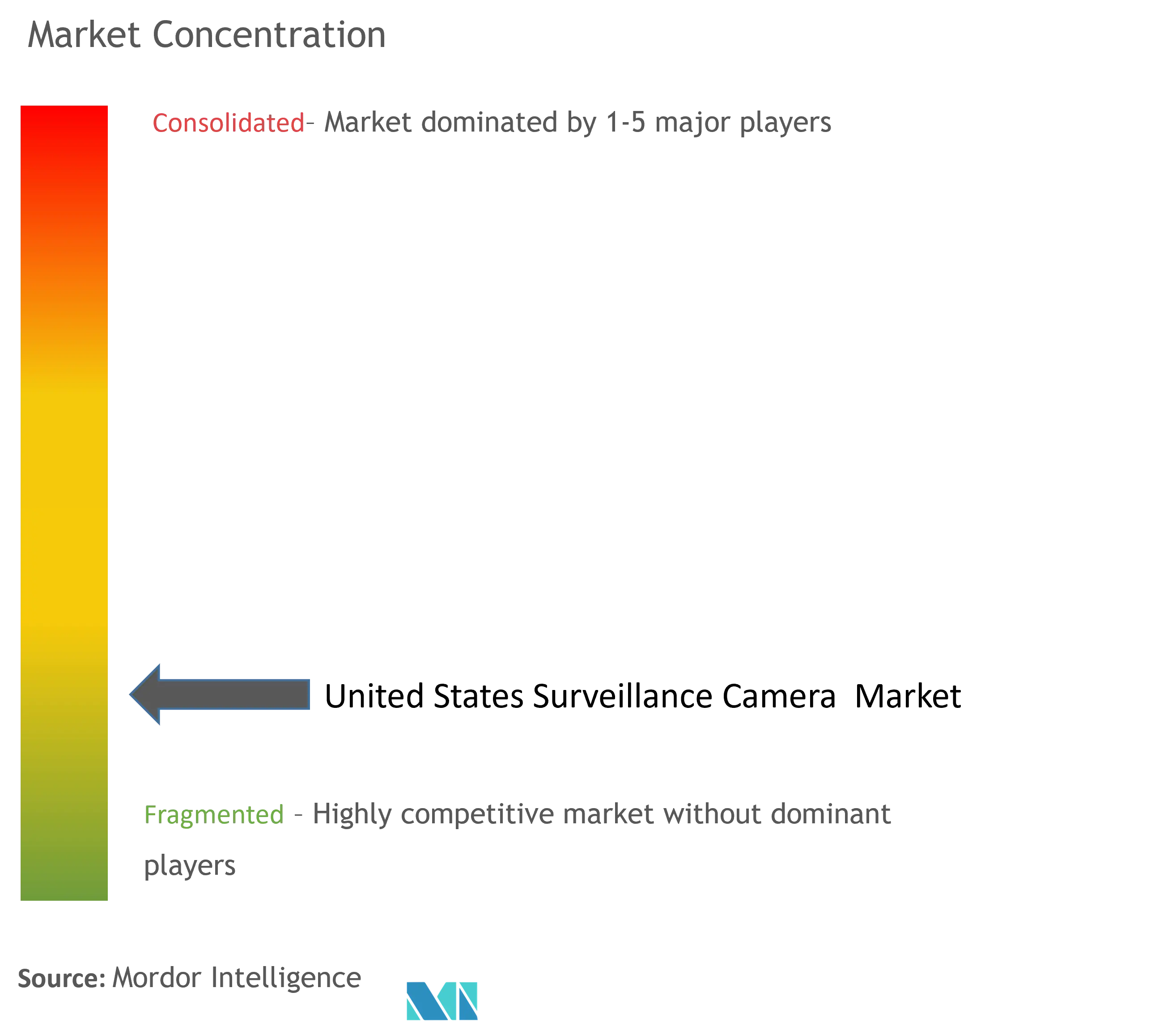United States Surveillance Camera Market Size

| Study Period | 2019 - 2029 |
| Base Year For Estimation | 2023 |
| Market Size (2024) | USD 6.20 Billion |
| Market Size (2029) | USD 10.94 Billion |
| CAGR (2024 - 2029) | 9.92 % |
| Market Concentration | Low |
Major Players
*Disclaimer: Major Players sorted in no particular order |
United States Surveillance Camera Market Analysis
The United States Surveillance Camera Market size is estimated at USD 6.20 billion in 2024, and is expected to reach USD 10.94 billion by 2029, growing at a CAGR of 9.92% during the forecast period (2024-2029).
- Over the past decade, the United States surveillance camera market has grown significantly, propelled by technological advancements, rising security concerns, and evolving regulations. Advancements in AI and ML have revolutionized surveillance systems. They bolster video analytics, enabling sophisticated features like facial recognition, behavior analysis, and object detection, enhancing system efficacy. Furthermore, the increasing adoption of Internet of Things (IoT) technology has streamlined connectivity and enabled remote monitoring, elevating the efficiency and user-friendliness of surveillance systems.
- Moreover, the US's macroeconomic conditions have been conducive to market growth, buoyed by heightened government spending on public safety. Notably, the US government allocated a substantial budget of USD 45.7 billion for the Department of Justice in FY2025, underscoring its commitment to security initiatives and setting a positive trajectory for the surveillance camera market.
- Several trends are reshaping the market landscape—notably, a pronounced shift towards cloud-based surveillance solutions, offering scalable storage and enhanced accessibility. Wireless cameras are gaining momentum and are lauded for their flexibility and straightforward installation. Furthermore, the trend of integrating surveillance systems with other smart devices and platforms is on a sharp rise.
- Cameras have evolved from video surveillance tools to pivotal AIoT (Artificial Intelligence of Things) components in the Internet of Everything. Companies are honing their visual technology, bolstering multi-dimensional perception, expanding application horizons, and spearheading the digitization of various sectors. This concerted effort aims to lay a robust foundation for intelligent applications.
- Moreover, companies are delving deeper into optical imaging research. They focus on overcoming traditional camera limitations, such as restricted views, night-time image clarity, and limited intelligent applications. This drive manifests in product enhancements, emphasizing ultra-HD, full-color, and panoramic details. Manufacturers also enhance night-time adaptability, highlighting features like full-color zoom capabilities, large aperture zooms, and stable light amounts for vivid picture quality.
- Several major US cities are heavily surveilled, with an average of over ten cameras per 1,000 residents. These cameras serve many functions, from traffic monitoring to crime prevention. Modern surveillance cameras boast high resolutions, offer remote access to live streams, and incorporate advanced technologies like facial and automatic license plate recognition (ALPR), cementing their status as a cornerstone of contemporary security measures.
- While challenges persist, such as heightened public awareness of privacy concerns leading to potential resistance against widespread surveillance and prompting stricter regulations, the market's adoption could be impacted. Additionally, as surveillance systems grow more interconnected, they face an escalating cyber-attack risk. Yet, implementing robust cybersecurity measures, though essential, can be both costly and technically demanding.
- Under the USD 1.9 trillion American Rescue Plan, the US government allocated USD 15 billion specifically for public safety initiatives. A recent report highlights a notable drop in crime rates nationwide, attributed to the increased focus on public safety. Notably, data from approximately 13,000 law enforcement agencies, covering about 82% of the US population, revealed a 13% decrease in murders and 6% and 4% drops in reported violent and property crimes, respectively, in 2023 compared to 2022. Despite these improvements, the demand for surveillance cameras is unlikely to wane. There's a growing trend of heightened investments in security products by consumers, businesses, and governments, aiming to fortify their premises and bolster public safety.
United States Surveillance Camera Market Trends
IP-based Surveillance Cameras is Expected to Witness Growth at a Significant Rate
- IP-based surveillance cameras transmit video data over an internet network, outshining traditional analog systems in the US market. Their ascendancy is fueled by advanced features, high resolutions, and adaptability, resonating with a security-conscious market amidst technological strides and broadening sectoral adoption. These cameras offer HD and UHD video quality, outclassing analog counterparts with crisper, more detailed imagery. Boasting remote access, digital zoom, and seamless integration with security systems, IP cameras are functional and user-friendly. Their scalability further stands out, enabling system expansions without significant infrastructure overhauls.
- The surge in smart home tech and IoT has heightened the demand for IP cameras, seamlessly integrating into broader home security and automation setups. While the initial investment might be steeper, IP cameras promise long-term savings through easy installation, minimal cabling, and reduced maintenance. Organizations increasingly turn to IP-based security cameras with video analytics, enhancing real-time situational awareness, fortifying security, and gaining valuable operational insights. With analytics proving pivotal, the advent of 4K resolution cameras empowers providers to embed advanced features into their management software.
- Artificial intelligence is a standout trend, elevating functionalities like facial recognition, behavior analysis, and automated alerts. Businesses, especially those eyeing future readiness, gravitate towards AI-capable surveillance systems. Furthermore, Cloud-based solutions offer significant cost efficiencies, while operational technology costs can sometimes be hidden. Transitioning computing and video storage to the cloud typically results in 20-50% lower ownership costs than onsite systems. Eagle Eye Network, an American company, highlights these savings, noting that approximately 76% of security customers opt for subscription agreements.
- The trend towards cloud storage and management, which facilitates scalable and accessible video storage and analysis, is further propelling the IP camera market. Some VSaaS providers are sweetening the deal, offering multiyear subscriptions with price protection, a move that's resonating with customers, especially as higher-resolution cameras become more affordable. Eagle Eye Networks' data underscores this shift, revealing a three-fold increase in high-resolution IP security cameras over the past five years.
- With the crime rate increasing across different parts of the country, the demand for advanced surveillance systems is anticipated to grow, creating a conducive environment for the studied market's growth. For instance, according to the National Insurance Crime Bureau (NICB), in 2023, more than one million vehicle theft cases were reported, with overall vehicle thefts increasing by about 1 % nationwide. The district of Colombia reported the highest growth (64%) compared to the previous year.

Retail Sector is Expected to Witness Significant Demand
- In the United States, the retail sector is witnessing a pivotal shift towards adopting surveillance cameras. This move is primarily fueled by the imperatives of loss prevention, bolstering customer safety, streamlining operations, and delving into consumer behavior insights. These cameras are not just tools but the frontline defense for safeguarding assets, creating secure shopping environments, and fine-tuning store management.
- One of the primary drivers behind this surge in surveillance camera deployment is the urgent need to combat theft, shoplifting, and internal fraud. Moreover, retailers are increasingly leveraging these cameras to ensure the safety of both customers and staff, extending their surveillance to store premises and parking lots. Beyond security, these cameras are now integral in monitoring day-to-day store activities, managing queues, and optimizing staff deployment.
- The US National Retail Federation reports that retail crime costs the industry over USD 100 billion. In a 2023 survey by the NRF, 52% of responding retailers indicated they are boosting their technology and software budgets. The top 10 security measures retailers find most effective in curbing losses include CCTV and video surveillance and upgraded or integrated CCTV systems.
- Retailers are increasingly turning to emerging technologies for loss prevention. The study reveals that 37% of respondents are exploring artificial intelligence-based analytics for e-commerce fraud detection, with 13% already having these systems in place. Additionally, 35% are looking into body-worn cameras for their staff. While 18% have already deployed mobile surveillance units in their parking lots, another 10% are in the process, and 19% are considering this technology for their stores.
- Retailers are actively exploring emerging technologies. While just 3% have fully embraced facial recognition, a significant 40% are either researching, piloting, or already implementing facial recognition or feature-matching technologies, as per NRF. NRF projects a 2024 retail sales growth of 2.5% to 3.5%.
- Furthermore, according to the US Census Bureau, in 2023, total retail sales in the United States reached USD 7.24 trillion. Hence, the anticipated rise in retail sales, coupled with the surge in the adoption of advanced surveillance cameras, is poised to propel the market forward.

United States Surveillance Camera Industry Overview
The United States Surveillance Camera market is fragmented, with major domestic and international players competing by offering technologically advanced products. The market features a wide range of manufacturers offering advanced technologies and solutions. Chinese manufacturers are major contenders and provide tough competition. Many global and domestic companies compete in the market, offering various surveillance camera types, software solutions, and integration services. Companies differentiate themselves through features like remote monitoring, cloud storage, easy integration with existing security systems, and customer support services.
- April 2024: BearCom, a prominent integrator of voice, security, and data solutions in North America, officially acquired The Surveillance Shop (TSS), a top-tier commercial security integrator based in Canada. TSS specializes in security camera systems, intrusion alarms, intercoms, access control, perimeter security, and land mobile radios.
- February 2024: South Korean video technology manufacturer IDIS broadened its lineup of Edge AI cameras; the company highlights that these new AI Edge cameras are versatile, finding applications in commercial settings, public areas, and perimeters. Leveraging AI, the cameras distinguish between humans, vehicles, and other objects. IDIS unveiled 12 new models in North America, ranging from 2MP and 5MP bullets to dome and turret cameras. Notably, some models will showcase NIR Lightmaster technology, enhancing image capture in low-light conditions.
United States Surveillance Camera Market Leaders
-
Axis Communications AB
-
Hangzhou Hikvision Digital Technology Co., Ltd.
-
Hanwha Vision America
-
Dahua Technology
-
Bosch Sicherheitssysteme GmbH
*Disclaimer: Major Players sorted in no particular order

United States Surveillance Camera Market News
- February 2024: Axis Communications unveiled its latest innovation in the realm of video surveillance management: Axis Cloud Connect. This cloud-based platform is designed to streamline and fortify video surveillance management. Axis assures customers of heightened security, increased flexibility, and enhanced scalability by leveraging its deep-rooted proficiency in network video surveillance.
- October 2023: Teledyne FLIR, a division of Teledyne Technologies Incorporated, unveiled its latest line of cameras alongside advanced security solutions. The new lineup includes three models: 5 MP, 4K Wide, and 4K Narrow, each boasting a suite of 12 distinct analytics tailored to identify people, vehicles, objects, attributes, and various events. Notably, the 4K Narrow variant offers impressive AI detection ranges of 152 meters (499 feet) for vehicles, 71 meters (233 feet) for individuals, and 25 meters (82 feet) for facial recognition.
United States Surveillance Camera Market Report - Table of Contents
1. INTRODUCTION
1.1 Study Assumptions and Market Definition
1.2 Scope of the Study
2. RESEARCH METHODOLOGY
3. EXECUTIVE SUMMARY
4. MARKET INSIGHTS
4.1 Market Overview
4.2 Industry Attractiveness - Porter's Five Forces Analysis
4.2.1 Bargaining Power of Suppliers
4.2.2 Bargaining Power of Consumers
4.2.3 Threat of New Entrants
4.2.4 Threat of Substitutes
4.2.5 Intensity of Competitive Rivalry
4.3 An Assessment of Impact of Macroeconomic Trends on The Market
5. MARKET DYNAMICS
5.1 Market Drivers
5.1.1 Increasing Use in Retail for Loss Prevention and Operation Efficiency
5.1.2 Technological Advancements Such As Use of Artificial Intelligence and Machine Learning
5.2 Market Restraints
5.2.1 Public Concern Over Privacy Invasion and Data Misuse
6. MARKET SEGMENTATION
6.1 By Type
6.1.1 Analog-based
6.1.2 IP-based
6.2 By End-user Industry
6.2.1 Government
6.2.2 Banking
6.2.3 Healthcare
6.2.4 Transportation & Logistics
6.2.5 Industrial
6.2.6 Retail
6.2.7 Other End-user Industries
7. COMPETITIVE LANDSCAPE
7.1 Company Profiles*
7.1.1 Axis Communications AB
7.1.2 Hangzhou Hikvision Digital Technology Co. Ltd
7.1.3 Hanwha Vision America
7.1.4 Dahua Technology
7.1.5 Bosch Sicherheitssysteme GmbH
7.1.6 Pelco
7.1.7 Avigilon Corporation (Motorola Solutions Inc.)
7.1.8 Vivotek Inc.
7.1.9 Teledyne FLIR (Teledyne Technologies)
7.1.10 Zhejiang Uniview Technologies Co. Ltd
7.1.11 IDIS Ltd
8. INVESTMENT ANALYSIS
9. FUTURE OF THE MARKET
United States Surveillance Camera Industry Segmentation
Surveillance cameras capture and record video footage for security and monitoring. They are used in public spaces, businesses, and homes to deter crime and enhance safety. The study tracks the revenue accrued through the sale of surveillance camera products by various players operating in the United States as the baseline for market estimations. The study also tracks the key market parameters, underlying growth influencers, and major vendors operating in the industry, which supports the market estimations and growth rates over the forecast period.
The United States surveillance camera market is segmented by type (analog-based, IP-based) and end-user industry (government, banking, healthcare, transportation & logistics, industrial, retail, and others). The market sizes and forecasts are provided in terms of value (USD) for all the above segments.
| By Type | |
| Analog-based | |
| IP-based |
| By End-user Industry | |
| Government | |
| Banking | |
| Healthcare | |
| Transportation & Logistics | |
| Industrial | |
| Retail | |
| Other End-user Industries |
United States Surveillance Camera Market Research FAQs
How big is the United States Surveillance Camera Market?
The United States Surveillance Camera Market size is expected to reach USD 6.20 billion in 2024 and grow at a CAGR of 9.92% to reach USD 10.94 billion by 2029.
What is the current United States Surveillance Camera Market size?
In 2024, the United States Surveillance Camera Market size is expected to reach USD 6.20 billion.
Who are the key players in United States Surveillance Camera Market?
Axis Communications AB, Hangzhou Hikvision Digital Technology Co., Ltd., Hanwha Vision America, Dahua Technology and Bosch Sicherheitssysteme GmbH are the major companies operating in the United States Surveillance Camera Market.
What years does this United States Surveillance Camera Market cover, and what was the market size in 2023?
In 2023, the United States Surveillance Camera Market size was estimated at USD 5.58 billion. The report covers the United States Surveillance Camera Market historical market size for years: 2019, 2020, 2021, 2022 and 2023. The report also forecasts the United States Surveillance Camera Market size for years: 2024, 2025, 2026, 2027, 2028 and 2029.
United States Surveillance Camera Industry Report
Statistics for the 2024 United States Surveillance Camera market share, size and revenue growth rate, created by Mordor Intelligence™ Industry Reports. United States Surveillance Camera analysis includes a market forecast outlook for 2024 to 2029 and historical overview. Get a sample of this industry analysis as a free report PDF download.



